Hello, Bob Aldons, The Car Guy with a follow up from my previous post on the 2018 JL Jeep Wrangler. As I mentioned, some international journalists were flown to New Zealand to be the first to test drive and write on the JL Jeep Wrangler. Can you imagine a better launch location than this? Arguably New Zealand has a vast difference in outlooks. From sleepy small villages, to a bustling metropolis with Auckland, to the most magnificent scenery you can imagine. Here in the land of Frodo Baggins and the Hobbits, JL Jeep Wrangler was tested and written about. My colleague from Autoweek provide the ‘road’ test.
“From beefier axles to heroic crawl ratios, here’s a closer look at what makes the JL Jeep Wrangler Rubicon trail conqueror
The 2018 JL Jeep Wrangler Rubicon is as good on the trail as it looks on paper — something we discovered in our first drive review. But there’s more to its chops than extra ground clearance and live axles. Here’s a closer look at nine of the new or improved features that contribute to its legendary capability.
- Axles that don’t bend
The old Wrangler JK Rubicon’s axle specs sound exceedingly strong. After all, there was a Dana 44 at each end — an axle that past served under the chassis of full-size pickup trucks for many years. That should be overkill for a Wrangler, right? Not so. A “Dana 44” isn’t always the same axle across various applications. And the one Jeep used in the front of the JK Rubicon had lighter-duty axle tubes. So, when subjected to heavy off-roading and the stresses of larger tires, it used to bend. Jeep fixed all that with the new JL, so the company could run larger 285/70R17 (33-inch) tires on the new Rubicon. That’s up from the 255/75R17 (32-inch) tires on the JK Rubicon. These new Dana 44 axles are beefier with stronger and thicker tubes as well as stronger forgings. The front axle has an 8.26-inch ring gear and the rear uses a larger 8.66-inch unit.
- Tighter turning
Those Dana 44 axles aren’t just stronger, they’re 1.5 inches wider, too. And that helped the engineers design in more steering angle into the new JL, so it could cut a 1-foot tighter turning circle than the old model. The improvement is very clear on the street and on the trail. In spots where a JK Wrangler would require an extra three-point turn, the new one carves the arc in one graceful move. That improved agility is helpful when rock crawling a tough trail because the fewer moves means fewer chances to get stuck. The new steering components are stronger, too. One look at the massive hollow 1.73-inch tie rod running across the axle and it’s clear the steering system has been designed to handle large tires and repeated rock bashing. Now that the Wrangler’s steering column both tilts and telescopes, it’s easier to find a comfortable place from which to take the helm.
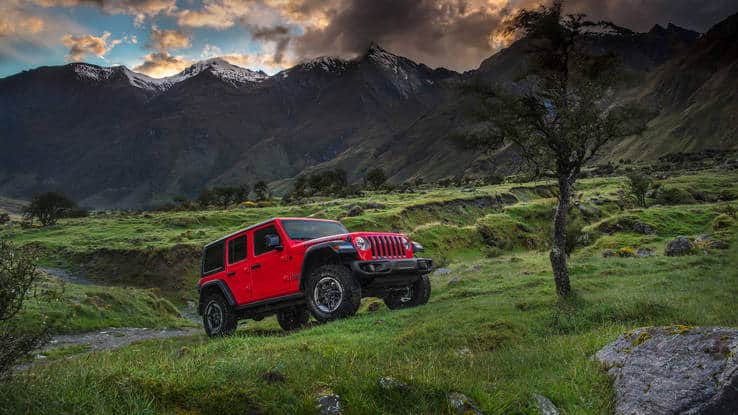
- Smoother suspension movements
The Wrangler has always been good at slow-speed trail work. However, when tackling rugged dirt roads or even the dreadful potholed pavement sections of a typical city, Wranglers weren’t very smooth-riding. The biggest problem was “head toss.” The Wrangler’s body rocked side to side on the suspension, making everyone onboard a little seasick. That’s eliminated on the new Wrangler JL. Chief engineer Brian Leyes says a big part of the solution was to raise the vehicle’s roll center by relocating the track bar. Though the overall wheel travel of the suspension is about the same, the team repositioned and lower control arms on the axle housing, slightly changing the geometry over the Wrangler JK. All this contributes to a ride that is much smoother and better isolated from the terrain than ever before.
- Big tire clearance
If you’re looking to mount big tires onto your Wrangler, its best to start with the Rubicon. The new Rubicon has unique fender flares and wheel openings to accommodate the 33-inch BF Goodrich K02 All-Terrain tires from the factory. Those hefty tires mean big ground clearance gains: There’s almost 11 inches under the differentials. On Jeep’s rock-crawl course, we never hit a diff on a rock. And the Jeep spotters working the course told us that their own Rubicon JK support vehicles had a noticeably tougher time making the climb. The Rubicon’s steel bumpers provide a whopping 44 degrees of approach angle up front and 37 degrees in the rear — so you can nose the Jeep onto big rocks (and back down again) without touching metal. Thanks to the axle upgrades and fender clearance, Jeep says you can run 35-inch tires with just a 2-inch lift. That’s a big gift to Jeep fans because in the past, owners needed to lift the Jeep by 3 to 4 inches, trim the fender flares or install high clearance flares to accommodate those tires at maximum suspension compression and steering lock.
- Quick fold windshield
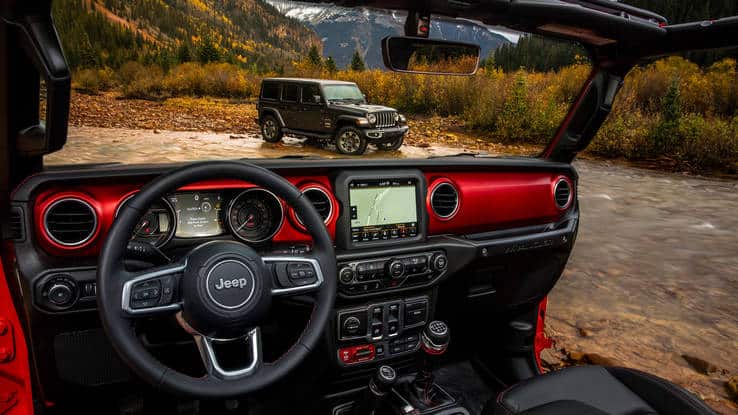
Down under, where we get more sunshine and off-road choices than anywhere else in the world, we can’t have the fold down windscreen. Call it what you want, policitcal correctness, work place health and safety, or what I choose to call it, Australia – The Nanny State , but surely if the yanks can have the choice, then we should too. After all, modifying this feature just for STRAYA, costs us more in the Retail Price, doesn’t it? So with this new system, which leaves in place the upper brace and mirror, perhaps the powers that be (Australian Design Regulators – the ones that allow ANCAP 2 and 3-star rating vehicles to be sold here) will relent
Jeep knows that few people actually fold down the windshield on their Wranglers. The feature has been in place since the very first Willys MB models of the 1940s. But by the time the JK Wrangler was launched in 2007, the process became laborious, requiring the removal of 28 bolts. It was prohibitively time-consuming. And because the tubes of the safety cage were bolted directly the windshield, when you lowered it, you lost structure. Now, there are just four bolts standing between you and open-air freedom. And Jeep has engineered the header to remain in place when the windshield is lowered. In fact, even the rearview mirror stays in place. The entire cage structure is composed of stiff ultra-high strength steel bars, so whether the windshield of the JL is up or down, it feels solid. And that combined with the ease of lowering that windshield will likely lead to more four-wheelers actually experiencing completely open-air Jeeping.
- 4WD front and center
Four-wheelers were blown away by the original TJ Rubicon model in 2003. One reason? The electric locking front and rear differentials. Simply press the switch and these lockers would send power equally to each wheel on an axle for serious traction. Those buttons were prominently displayed in the center console ahead of the shifter on TJ and early JK Rubicons. But when Jeep remodeled the JK Wrangler interior for 2012, Jeep decided to bury them to the left of the steering wheel where they are difficult to access and see in bright sunlight. So, it was not uncommon to be in a tough spot on the trail, reach for the button to turn on the front locker, and mistakenly turn the rear one off. No more. Jeep has gone to a simple toggle switch. Press down to turn on the rear locker and up to turn on both the front and rear. They’ve once again mounted the switches just ahead of the shifters and even surrounded them in bright red trim, so they’re easy to find and use.
- Chassis quake: Eliminated
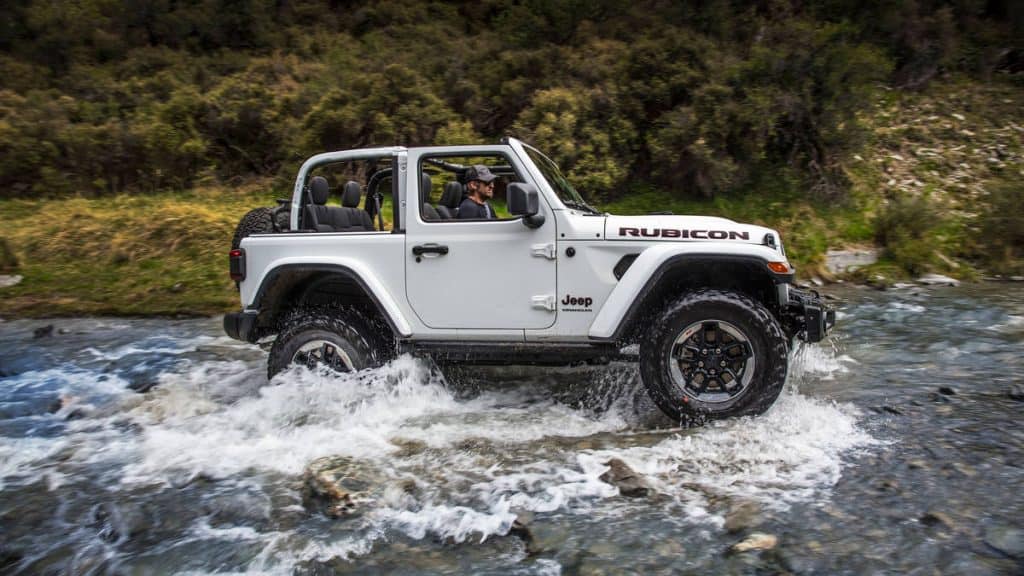
The body-on-frame structure of the old Wrangler JK was strong, but there were quite a few circumstances when it would quake and quiver over bumps off-road. When driving on a dirt fire road at speed, the Wrangler’s steering column would shake and shimmy, as would the windshield. You could hear and feel the quivers in the chassis. That’s been remedied on the new JL. The culprit was the frame, according to chief engineer Leyes. The all-new frame is now fully-boxed with a hydroformed front section and uses 80 percent high strength steel, a “big jump”, Leyes says, over the JK. Torsional stiffness has been increased by 18 percent too. The bending stiffness is about equal to the current JK. The new frame is actually 100 pounds lighter than the old one as well, and there’s a new design for all the body mounts which contributes to much better isolation from the road or trail.
- Levers only, please
When it comes to 4WD, the Rubicon keeps it simple. Jeep knew its customers weren’t interested in a sophisticated system like the knob-controlled, multi-mode Selec-Terrain in the Grand Cherokee. Leyes days a system like that was never on their radar for the Rubicon (the Sahara, however, will get something slightly different: Selec-Trac). “Customers said, we want to have that lever— don’t mess with it,” said Leyes. And so, they left the transfer case itself largely the same as the outgoing Wrangler JK Rubicon. However, there’s an all-new manual transmission which is available only on the V6 model. This new D478 gearbox is still a six-speed but has a deeper 5.13:1 First gear ratio. And that means a manual transmission Rubicon with 4.10:1 axle gears will have a crawl ratio of 84:1. The new eight-speed automatic has a deeper First gear than the old five-speed automatic as well. So auto-equipped Wrangler Rubicons can manage a crawl ratio of 77.2:1. Those are heroic numbers and it means the JL can creep along a trail more slowly than any other 4X4 — and have the proper gearing to turn larger-than-stock tires right off the showroom floor.
- Don’t fear the four
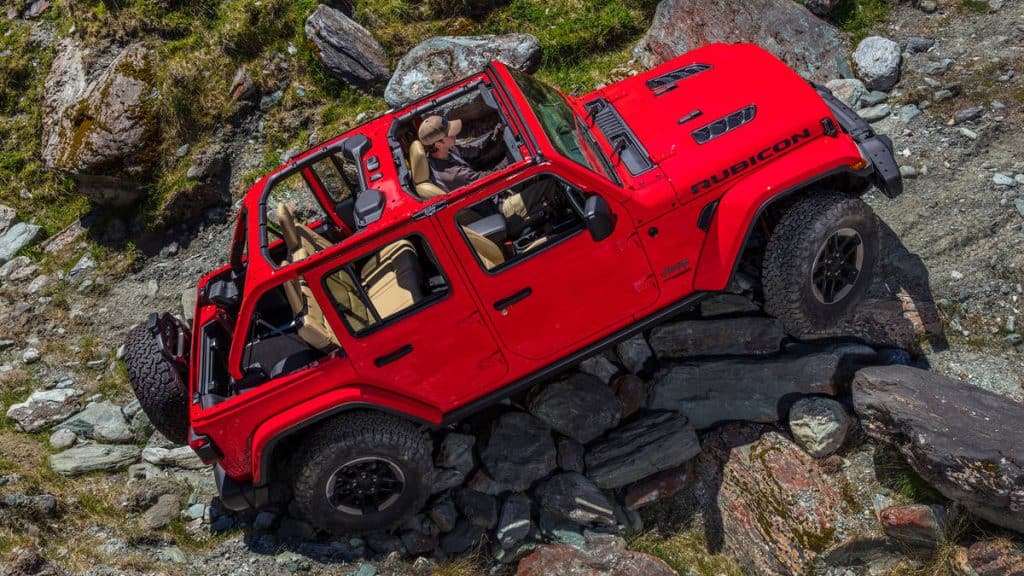
For decades, Wrangler fanatics have yearned for an optional V8 engine under the hood. But instead of the throaty growl of a Hemi, Jeep is offering a 2.0-liter turbocharged four-cylinder as the optional gas engine above the V6. We were skeptical. But after spending time with both engines on the pavement and off, we found it to be a terrific powerplant. The V6 makes 285 hp up at 6,400 rpm. The 2.0-liter might make a bit less (270 hp) but it peaks at a lower 5,350 rpm. Even more telling, the four-cylinder develops bigger torque — a healthy 295 lb-ft at 3,000 rpm. The V6 develops just 260 lb-ft and does it way up at 4,600 rpm. The result, according to our informal stopwatch timing, is a 0-60 mph run that is consistently around a second quicker (7 seconds versus 8 seconds) in models equipped with the four-cylinder. And when driving trails, the four-cylinder delivers more torque, sooner. On Jeep’s hardcore 4WD test trail, we crawled the terrain in a Rubicon with this new four-cylinder and never felt it lacking for torque. Of course, once Jeep’s Ecodiesel with 442 lb-ft of torque becomes available in 2019, we might have to reevaluate our options.”

BEN STEWART – Ben Stewart has spent the past two decades reviewing cars and reporting on automotive culture and technology.

Bob Aldons is the owner and founder of The Car Guy, reviewing cars, reporting on Car Industry Matters, Car Tech and the world at large. He’s spent the last forty years immersed in the automotive industry from salesman to the owner of a 7 brand multi-franchise dealership. Bob knows cars.
Find One
If you’re hunting around for a great price on your JL Jeep Wrangler or any other new car, you should call the auto expert, Bob Aldons from Car Business. My company, a car Broker, Car Buyers Agent or Car Buyers Advocate based on the north side of Brisbane, will return your inquiry within 24 hours and make the process of buying a new car easy and stress-free. Are you tired of salesperson tricks? I protect you from the pressure exerted by car dealer’s salespeople. There isn’t any obligation – just a pretty significant saving.
You’re where? Seriously, my services are available for you in any Australian state and territory: from Darwin to Hobart, Cairns to Perth. Car Broker Brisbane, Sydney, Melbourne, Adelaide, Perth, Hobart, and Darwin – I’m available when you need me to be.
Here’s an example
Matt wanted to purchase a Mazda 3 SP25 GT Manual Hatch. The retail value, drive away on that car is around $35,000. Car Business managed to purchase the same car for $28, 123.90 and with our fee Matt paid $25, 588, a saving of over $6000. And how do we know? Another customer, (looking for a new Holden HSV) just paid $35,000 for the same car – but he did it himself, without our assistance
If you’ve got a vehicle to trade, we have some clever ways to maximize the value – from used car dealers keen for your car to assist you to sell it privately. Finance and Insurance? We can handle that too, and we promise you will not be paying exorbitant dealer markups there either.
Trade In Value Example
2014 Jeep Cherokee Limited. Average dealer trade value – $16500. We achieved $22,000
2014 Volkswagen Tiguan 118TSI. Average dealer trade value – $14000. We achieved $16000
So, to get the best new car price, talk to others and then talk me. I’ve got the experience to handle the dealers and achieve the lowest new car prices. If you think you’re entitled to fleet pricing, I can often get better than that too. Whether you’re a small fleet or a large national fleet, Car Business will go to work and get that price down. Lower new car prices are my goal. So you’ll get the best prices from us rather than hoping you can help yourself.
If I can’t get you the best new car price, better than you can get yourself from a car dealer, we won’t charge you any fee. No Saving, No Fee. – that’s what you should expect from a car buying expert.
Car Business WILL save you money on your next new car purchase – guaranteed
Read more: http://autoweek.com/article/car-reviews/9-reasons-why-2018-jeep-wran
ler-rubicon-jl-killer-road#ixzz51GjPOHVd

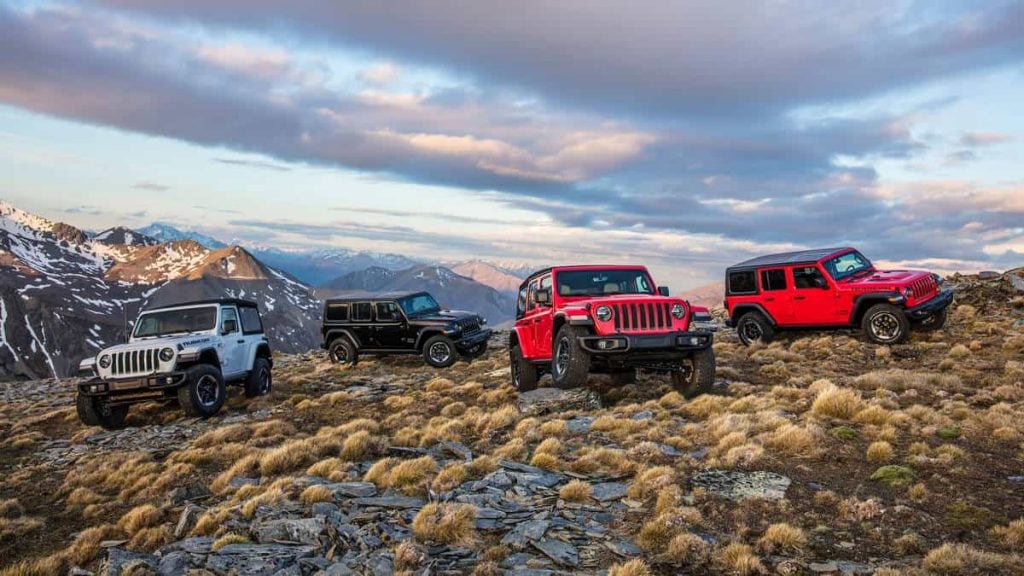
Hi, Can someone please guide me if Australia is getting JL Manual Rubicon
I now have 14,379 miles on my JL Rubicon. Over 80% has been off road, mainly in Moab, Utah, Siverton, Co. & mountains of New Mexico. It’s bone stock with the 3.6 pen star &auto trans. One word- Awsome ! Goes anywhere, period. Very comftorable,easy to drive, everything works like it should. In 4 low all day crawling in Moab it got 6.7 mpg. The tires a worn past 75%, but where it’s been @ 14 psi is no surprise. I’m 75, & have owned many off road vehicles-this is simply the best.